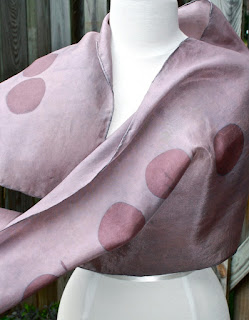With apologies to Dr. Seuss...
Well, not JUST an indigo vat. These scarves were dipped (how many times for each, I don't know) in an indigo vat and left to oxidize for several days. Next I immersed them both in a vat of Quebracho red with walnut dye solution added as an afterthought. I was just playing -- who knows how long or how much of each quantity I added!
Finally, I clamped on some circular disks to create a shibori resist and then immersed each scarf in a discharge vat. I used thiox to discharge the color -- which is the same ingredient used in my indigo bath to reduce the oxygen. Hence the unusual colors, because the thiox reactivated the indigo, creating wonderful and definitely unpredictable colors.
If anyone reading this knows more about why this happened, I would love to hear from you! I've had this happen before, where a discharge bath can reactivate the indigo color. I also know that an indigo bath can act as a discharge vat for other colors.
For the circle designs, I sometimes used wooden disks that had some blue acid dye still on them. It makes the circles look like the sun in an eclipse.
Finally, I clamped on some circular disks to create a shibori resist and then immersed each scarf in a discharge vat. I used thiox to discharge the color -- which is the same ingredient used in my indigo bath to reduce the oxygen. Hence the unusual colors, because the thiox reactivated the indigo, creating wonderful and definitely unpredictable colors.
If anyone reading this knows more about why this happened, I would love to hear from you! I've had this happen before, where a discharge bath can reactivate the indigo color. I also know that an indigo bath can act as a discharge vat for other colors.
For the circle designs, I sometimes used wooden disks that had some blue acid dye still on them. It makes the circles look like the sun in an eclipse.














